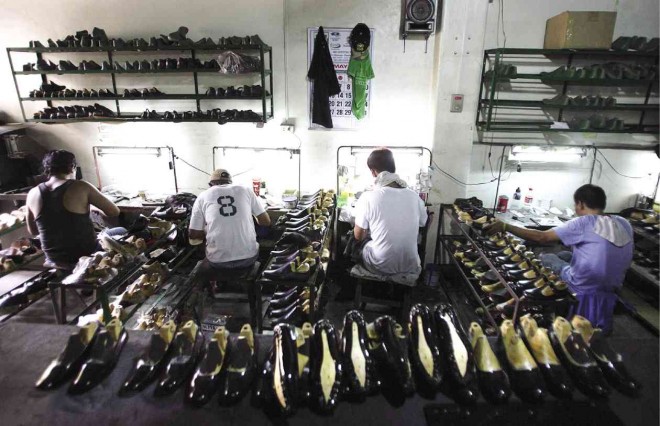Marikina’s wish: Wear our shoes for Sona fashion

MUST CATCH UP Marikina’s 134-year-old shoe industry went into online retailing just recently. LYN RILLON
MARIKINA Mayor Del de Guzman is encouraging lawmakers attending President Aquino’s State of the Nation Address (Sona) on Monday to give his city’s 134-year-old shoe industry a boost by hitting the Sona red carpet in Marikina-made footwear.
“Wearing Marikina-made shoes will not only complement their Filipiniana outfit made by local designers, but it’s also a great help in revitalizing the local shoe industry, the source of livelihood for thousands of our residents,” De Guzman said on Saturday.
“This is a big help to the city of Marikina especially to its ailing shoe industry, which is continuously moving forward and relentlessly producing shoes that are of genuine quality and durability,” said the mayor and former congressman, as he also thanked Marikina Rep. Romero Federico Quimbo for making a similar appeal to fellow lawmakers.
Earlier this month, the city government launched the campaign #iWearMarikina to encourage its own residents to patronize locally made shoes, as well as the online shopping website marikinashoes.theshop.ph. which pushes local brands like A-fit-tizer, Checkpoint, Fontelle, Medz, Valentino, Pads Shuz, Ellen & Mae, Gibson and Alicia.
Shoe engineering course
Article continues after this advertisementAs part of a long-term revival effort, the city will soon be offering the country’s first shoe engineering course to train a new generation of craftsmen and entrepreneurs, under the expanded basic education program also known as K to 12.
Article continues after this advertisementThe course, developed by the Marikina Shoe Industry Development Office (Masido), is currently being reviewed by the Technical Education and Skills Development Authority (Tesda) in time for its pilot implementation at San Roque National High School and Marikina High School. It will fall under the senior high school program’s technical-vocational track.
In a recent Inquirer interview, Masido technical consultant Noel Box said the course would teach not only the art and science of shoemaking at a more professional level but also sound business models that go beyond backyard operations.
The course was developed following a citywide survey conducted earlier this year, which found that at least 134 students were interested in footwear manufacturing. Box noted that most of these students come from families without any background in that industry.
It’s still “a good number to begin with,” said Box, himself one of the scholars who took a similar course offered by the United Nations Industrial Development Organization in the late 1980s to the early 1990s.
That course was conceptualized by Europeans and was offered in the country through Tesda’s precursor—the National Manpower and Youth Council—after the 1986 Edsa People Power Revolution as a response to the competition posed by the growing Chinese footwear industry.
But most of the local manufacturers snubbed the program then “because the shoe industry didn’t have an idea about it,” Box recalled.
The Marikina shoe industry is said to be pioneered by
Laureano Guevara in 1881. According to Philippine Footwear Federation director general Roger Py, it experienced rapid growth from the 1960s to the early 1990s.
But local players started feeling the impact of Chinese imports in the early 2000s, when sales took a plunge and forced many manufacturers to close shop. Some tried to compete by matching the Chinese pricing. But Py lamented how quality was sacrificed when local manufacturers started producing cheap footwear.
Local vs China production
Box said the local industry produces only around 20 to 30 million pairs annually, yet the total market demand is at 210 million pairs a year. Of that volume, Marikina can produce only about five to 10 million pairs—as opposed to 16 billion pairs churned out for export by China.
The only way for Marikina to redeem its status on the global stage is for manufacturers “to make comfortable and quality shoes and not compete with China,” he said.
In that respect, Box has reason to be optimistic. Aside from the development of a shoemaking course, the city government’s Cottage Industry Training Center has procured state-of-the-art equipment that local shoe manufacturers can use for a minimal fee to test if their designs could meet international standards.
The digitized process allows them to test their new models’ durability and flexibility, for example, before proceeding with their mass production. With a report from Maera Tezuka